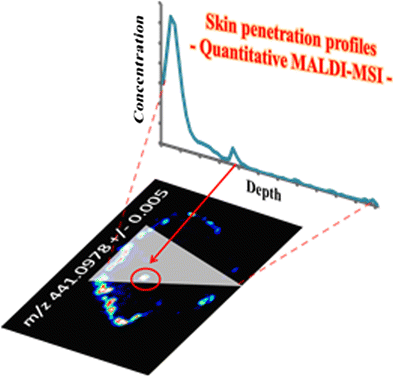Analytical and Bioanalytical Chemistry ( IF 3.8 ) Pub Date : 2018-03-15 , DOI: 10.1007/s00216-018-0964-3 David Bonnel 1 , Raphaël Legouffe 1 , André H Eriksson 2 , Rasmus W Mortensen 2 , Fabien Pamelard 1 , Jonathan Stauber 1, 3 , Kim T Nielsen 2
Generation of skin distribution profiles and reliable determination of drug molecule concentration in the target region are crucial during the development process of topical products for treatment of skin diseases like psoriasis and atopic dermatitis. Imaging techniques like mass spectrometric imaging (MSI) offer sufficient spatial resolution to generate meaningful distribution profiles of a drug molecule across a skin section. In this study, we use matrix-assisted laser desorption/ionization mass spectrometry imaging (MALDI-MSI) to generate quantitative skin distribution profiles based on tissue extinction coefficient (TEC) determinations of four different molecules in cross sections of human skin explants after topical administration. The four drug molecules: roflumilast, tofacitinib, ruxolitinib, and LEO 29102 have different physicochemical properties. In addition, tofacitinib was administrated in two different formulations. The study reveals that with MALDI-MSI, we were able to observe differences in penetration profiles for both the four drug molecules and the two formulations and thereby demonstrate its applicability as a screening tool when developing a topical drug product. Furthermore, the study reveals that the sensitivity of the MALDI-MSI techniques appears to be inversely correlated to the drug molecules’ ability to bind to the surrounding tissues, which can be estimated by their Log D values.

Graphical abstract
中文翻译:

MALDI 成像通过确定定量皮肤分布图来促进新的局部药物开发过程
在用于治疗银屑病和特应性皮炎等皮肤病的局部产品的开发过程中,生成皮肤分布图和可靠确定目标区域的药物分子浓度至关重要。质谱成像 (MSI) 等成像技术提供了足够的空间分辨率,可以生成有意义的药物分子在整个皮肤部分的分布图。在这项研究中,我们使用基质辅助激光解吸/电离质谱成像 (MALDI-MSI) 根据局部给药后人体皮肤外植体横截面中四种不同分子的组织消光系数 (TEC) 测定生成定量皮肤分布图. 四种药物分子:罗氟司特、托法替尼、鲁索替尼、和 LEO 29102 具有不同的理化性质。此外,托法替尼以两种不同的制剂给药。研究表明,使用 MALDI-MSI,我们能够观察到四种药物分子和两种制剂的渗透曲线差异,从而证明其在开发局部药物产品时作为筛选工具的适用性。此外,该研究表明,MALDI-MSI 技术的敏感性似乎与药物分子与周围组织结合的能力呈负相关,这可以通过它们的 Log D 值来估计。我们能够观察到四种药物分子和两种制剂的渗透曲线差异,从而证明其在开发局部药物产品时作为筛选工具的适用性。此外,该研究表明,MALDI-MSI 技术的敏感性似乎与药物分子与周围组织结合的能力呈负相关,这可以通过它们的 Log D 值来估计。我们能够观察到四种药物分子和两种制剂的渗透曲线差异,从而证明其在开发局部药物产品时作为筛选工具的适用性。此外,该研究表明,MALDI-MSI 技术的敏感性似乎与药物分子与周围组织结合的能力呈负相关,这可以通过它们的 Log D 值来估计。

图形概要











































 京公网安备 11010802027423号
京公网安备 11010802027423号